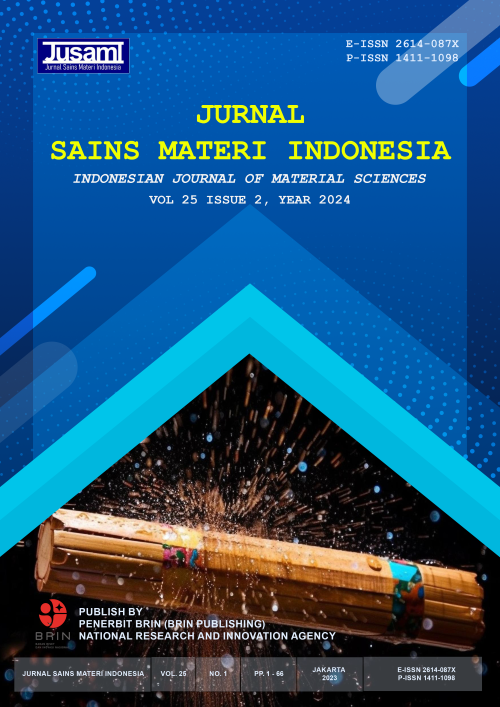Adsorption Study of Methylene Blue and Methyl Red on Activated Carbon from Silver Composite Using the Extract of Spent Coffee Grounds
DOI:
https://doi.org/10.55981/jsmi.2024.924Keywords:
Activated Carbon, Silver Composite, Spent Coffee Grounds, Methylene Blue, Methyl RedAbstract
The activated carbon was prepared from silver composite via an extract of spent coffee grounds with phosphoric acid activation. The activated carbon was used to study the removal of methylene blue and methyl red from an aqueous medium. Fourier-transform infrared spectroscopy (FTIR) spectra confirmed the functional group of O–P–O that can interact with dye molecules and the reduction process of Ag+ to Ag0. Field Emission Scanning Electron Microscopy (FESEM) morphology suggests a porous and irregular polygonal shape. The efficiency removal and adsorption capacity of methylene blue reached 98.73% and 9.87 mg/g at pH 9, while methyl red reached 98.55% and 9.86 mg/g at pH 4. The kinetics adsorption study followed the pseudo-first order. The isotherm adsorption study followed the Langmuir model. Based on the kinetics and isotherm study, the adsorption study of methylene blue and methyl red is chemical sorption.
Downloads
References
M. Rafatullah, O. Sulaiman, R. Hashim, and A. Ahmad. “Adsorption of methylene blue on low-cost adsorbents: A review.” J. Hazard. Mater., vol. 177, no. 1–3, pp. 70–80, 2010.
B. H. Hameed and F. B. M. Daud. “Adsorption studies of basic dye on activated carbon derived from agricultural waste: Hevea brasiliensis seed coat.” Chem. Eng. J., vol. 139, no. 1, pp. 48–55, 2008.
E. A. Khan, Shahjahan, and T. A. Khan. “Adsorption of methyl red on activated carbon derived from custard apple (Annona squamosa) fruit shell: Equilibrium isotherm and kinetic studies.” J. Mol. Liq., vol. 249, pp. 1195–1211, 2018.
R. Al-Tohamy, S. S. Ali, F. Li, K. M. Okasha, Y. A.-G. Mahmoud, T. Elsamahy, H. Jiao, Y. Fu, and J. Sun. “A critical review on the treatment of dye-containing wastewater: Ecotoxicological and health concerns of textile dyes and possible remediation approaches for environmental safety.” Ecotoxicol. Environ. Saf., vol. 231, p. 113160, 2022.
C. Flores, F. Ventura, J. Martin-Alonso, and J. Caixach. “Occurrence of perfluorooctane sulfonate (PFOS) and perfluorooctanoate (PFOA) in N.E. Spanish surface waters and their removal in a drinking water treatment plant that combines conventional and advanced treatments in parallel lines.” Sci. Total Environ., vol. 461–462, pp. 618–626, 2013.
M. Sulyman, J. Namiesnik, and A. Gierak. “Low-cost adsorbents derived from agricultural by-products/wastes for enhancing contaminant uptakes from wastewater: A review.” Polish J. Environ. Stud., vol. 26, no. 2, pp. 479–510, 2017.
P. Xu, X. Han, B. Zhang, Y. Du, and H. L. Wang. “Multifunctional polymer-metal nanocomposites via direct chemical reduction by conjugated polymers.” Chem. Soc. Rev., vol. 43, no. 5, pp. 1349–1360, 2014.
S.-M. Li, N. Jia, M.-G. Ma, Z. Zhang, Q.-H. Liu, and R.-C. Sun. “Cellulose–silver nanocomposites: Microwave-assisted synthesis, characterization, their thermal stability, and antimicrobial property.” Carbohydr. Polym., vol. 86, no. 2, pp. 441–447, 2011.
J. Nyirenda, G. Kalaba, and O. Munyati. “Synthesis and characterization of an activated carbon-supported silver-silica nanocomposite for adsorption of heavy metal ions from water.” Results Eng., vol. 15, no. August, p. 100553, 2022.
M. Lewoyehu. “Comprehensive review on synthesis and application of activated carbon from agricultural residues for the remediation of venomous pollutants in wastewater.” J. Anal. Appl. Pyrolysis, vol. 159, p. 105279, 2021.
D. Gogoi, M. Kumar, and Y. G. Lakshmi. “A comprehensive review on ‘Pyrolysis’ for energy recovery.” Bioenergy Res., no. January, 2023.
F. Codignole Luz, M. Volpe, L. Fiori, A. Manni, S. Cordiner, V. Mulone, and V. Rocco. “Spent coffee enhanced biomethane potential via an integrated hydrothermal carbonization-anaerobic digestion process.” Bioresour. Technol., vol. 256, pp. 102–109, 2018.
S. S. Arya, R. Venkatram, P. R. More, and P. Vijayan. “The wastes of coffee bean processing for utilization in food: A review.” J. Food Sci. Technol., vol. 59, no. 2, pp. 429–444, 2022.
N. Dwivedi and S. Dwivedi. “Chapter 22 - Sustainable biological approach for removal of cyanide from wastewater of a metal-finishing industry,” in Membrane-Based Hybrid Processes for Wastewater Treatment, M. P. Shah and S. B. T.-M.-B. H. P. for W. T. Rodriguez-Couto, Eds. Elsevier, 2021, pp. 463–479.
P. N. Omo-Okoro, C. E. Maepa, A. P. Daso, and J. O. Okonkwo. “Microwave-assisted synthesis and characterization of an agriculturally derived silver nanocomposite and its derivatives.” Waste and Biomass Valorization, vol. 11, no. 5, pp. 2247–2259, 2020.
L. F. Ballesteros, J. A. Teixeira, and S. I. Mussatto. “Chemical, functional, and structural properties of spent coffee grounds and coffee silverskin.” Food Bioprocess Technol., vol. 7, no. 12, pp. 3493–3503, 2014.
J. J. Gao, Y. B. Qin, T. Zhou, D. D. Cao, P. Xu, D. Hochstetter, and Y. F. Wang. “Adsorption of methylene blue onto activated carbon produced from tea (Camellia sinensis L.) seed shells: Kinetics, equilibrium, and thermodynamics studies.” J. Zhejiang Univ. Sci. B, vol. 14, no. 7, pp. 650–658, 2013.
M. R. H. Siddiqui, S. F. Adil, M. E. Assal, R. Ali, and A. Al-Warthan. “Synthesis and characterization of silver oxide and silver chloride nanoparticles with high thermal stability.” Asian J. Chem., vol. 25, no. 6, pp. 3405–3409, 2013.
W. Jastrzębski, M. Sitarz, M. Rokita, and K. Bułat. “Infrared spectroscopy of different phosphates structures.” Spectrochim. Acta Part A Mol. Biomol. Spectrosc., vol. 79, no. 4, pp. 722–727, 2011.
N. El-Desouky, K. Shoueir, I. El-Mehasseb, and M. El-Kemary. “Synthesis of silver nanoparticles using bio valorization coffee waste extract: Photocatalytic flow-rate performance, antibacterial activity, and electrochemical investigation.” Biomass Convers. Biorefinery, no. 0123456789, 2022.
A. A. Bhutto, Ş. Kalay, S. T. H. Sherazi, and M. Culha. “Quantitative structure–activity relationship between antioxidant capacity of phenolic compounds and the plasmonic properties of silver nanoparticles.” Talanta, vol. 189, no. March, pp. 174–181, 2018.
A. Scroccarello, B. M.-H. Junior, F. D. Pelle, J. Ciancetta, G. Ferraro, E. Fratini, L. Valbonetti, C. C. Copez, D. Compagnone. “Effect of phenolic compounds-capped AgNPs on growth inhibition of Aspergillus niger.” Colloids Surfaces B Biointerfaces, vol. 199, no. September 2020, 2021.
N. U. H. Altaf, M. Y. Naz, S. Shukrullah, M. Ghamkar, M. Irfan, S. Rahman, T. Jakubowski, E. A. Alqurashi, A. Glowacz, and M. H. Mahnashi. “Non-thermal plasma reduction of Ag+ ions into silver nanoparticles in open atmosphere under statistically optimized conditions for biological and photocatalytic applications.” Materials (Basel)., vol. 15, no. 11, pp. 1–24, 2022.
O. Oginni, K. Singh, G. Oporto, B. Dawson-Andoh, L. McDonald, and E. Sabolsky. “Effect of one-step and two-step H3PO4 activation on activated carbon characteristics.” Bioresour. Technol. Reports, vol. 8, p. 100307, 2019.
F. Ortega, L. Giannuzzi, V. B. Arce, and M. A. García. “Active composite starch films containing green synthetized silver nanoparticles.” Food Hydrocoll., vol. 70, pp. 152–162, 2017.
I. Khan, K. Saeed, I. Zekker, B. Zhang, A. H. Hendi, A. Ahmad, S. Ahmad, N. Zada, H. Ahmad, L. A. Shah, T. Shah, and I. Khan. “Review on methylene blue: Its properties, uses, toxicity and photodegradation.” Water (Switzerland), vol. 14, no. 2, 2022.
L. I. U. Qiong, C. Yu-miao, and L. I. U. Zhao-qing. “Determination of acid dissociation constant of methyl red by multi-peaks gaussian fitting method based on UV-Visible absorption spectrum,” vol. 28, no. 5, pp. 1030–1036, 2012.
T. Q. Tuan, N. V. Son, H. T. K. Dung, N. H. Luong, B. T. Thuy, N. T. V. Anh, N. D. Hoa, and N. H. Hai. “Preparation and properties of silver nanoparticles loaded in activated carbon for biological and environmental applications.” J. Hazard. Mater., vol. 192, no. 3, pp. 1321–1329, 2011.
J. M. Gómez, J. Galán, A. Rodríguez, and G. M. Walker. “Dye adsorption onto mesoporous materials: pH influence, kinetics and equilibrium in buffered and saline media.” J. Environ. Manage., vol. 146, pp. 355–361, 2014.
A. Molla, Y. Li, B. Mandal, S. G. Kang, S. H. Hur, and J. S. Chung. “Selective adsorption of organic dyes on graphene oxide: Theoretical and experimental analysis.” Appl. Surf. Sci., vol. 464, pp. 170–177, 2019.
L. S. Maia, A. I. C. da Silva, E. S. Carneiro, F. M. Monticelli, F. R. Pinhati, and D. R. Mulinari. “Activated carbon from palm fibres used as an adsorbent for methylene blue removal.” J. Polym. Environ., no. 0123456789, 2020.
E. G. Lemraski and Z. Palizban. “Comparison of 2-amino benzyl alcohol adsorption onto activated carbon, silicon carbide nanoparticle and silicon carbide nanoparticle loaded on activated carbon.” J. Mol. Liq., vol. 212, pp. 245–258, 2015.
P. Pourhakkak, A. Taghizadeh, M. Taghizadeh, M. Ghaedi, and S. Haghdoust. “Chapter 1 - Fundamentals of adsorption technology,” in Adsorption: Fundamental Processes and Applications, M. Ghaedi, Ed., in Interface Science and Technology, vol. 33. Elsevier, 2021, pp. 1–70.
Downloads
Published
How to Cite
Issue
Section
License
Copyright (c) 2024 Haidar Sitie Rafidah, Hafiizh Prasetia, Asep Saefumillah

This work is licensed under a Creative Commons Attribution-ShareAlike 4.0 International License.








